Abstract
Antimicrobial textiles have played an increasingly important protection role in the medical field. With this aim, Schiff bases and nanometal complexes on the cotton fabric were in situ synthesized for achieving the conventional cotton fabric’s highly efficient and durable UV protection and antibacterial properties. Herein, a new Schiff base derived from the condensation reaction of 2,4-dihyroxybenzaldehyde with p-amino aniline was synthesized. Co, Ni, Cu, and Zn complexes of the Schiff base were also prepared and characterized by UV-Vis, Fourier-transform infrared spectroscopy, 1HNMR, 13CNMR, elemental analysis, and thermal analysis. The modified cotton fabric was also characterized via X-ray diffraction, Fourier-transform infrared spectroscopy (FTIR), scanning electron microscope (SEM), transition electron microscope (TEM), and Energy Dispersive X-Ray Analysis (EDX). Moreover, the microbial, UV protection, and tensile strength of the samples were investigated. The antimicrobial was studied against Gram-positive bacteria, Gram-negative bacteria, and fungal strains. Modified cotton fabric exhibited highly antibacterial activity in contrast with fungal activity. These results depended on the Schiff base and the type of metal complex. The results also show that the cotton fabric modified by in situ nanometal complexes provides excellent UV protection.
1. Introduction
Cotton is a plentiful natural fiber made up almost entirely of cellulose with hydroxyl functional groups (about 88%–96%). It is one of the most extensively used natural fibers in everyday life due to its high hygroscopicity, soft comfort, and biodegradability. In textile and biomedical engineering, the biopolymeric cotton fabric material offers a variety of benefits. On the other hand, cotton textiles promote the growth of microorganisms, such as bacteria and fungus, which spread diseases, significantly raise the risk of cross-infection, and even damage human health [1]. Hence, the search for the ways of imparting cotton fabrics with antibacterial properties is crucial. Different types of antibacterial agents, such as N-halamine [2], quaternary ammonium salts [3], nanomaterials [4,5,6], chitosan [7], reduced graphene oxide/silver nanocomplexs [8], and curcumin/titanium dioxide nanocomposites [9], have been developed to add antibacterial activity.
Schiff bases are the condensation products of primary amines with carbonyl compounds (aldehydes and ketones) [10]. Hugo Schiff, a German chemist, first reported Schiff bases in 1864; hence, the name Schiff bases. Schiff bases are sometimes known as azomethines or imines [11]. The common structural feature of Schiff bases is azomethine group linked with substituents (R-C=N-R’), these substituents may be cycloalkyl, alkyl, heterocyclic, or aryl groups [11]. The Schiff base metal complexes’ importance has been recognized in the fields of material sciences, bioinorganic chemistry, biomedical applications, and supramolecular chemistry.
Schiff base metal complexes make available compounds naturally and synthetic oxygen carriers [12] and also offer compounds that operate as active stereospecific catalysts in redox, hydrolysis, and conversion reactions in organic and inorganic processes [13]. Metals, in addition to their complexes, have had important applications in medical applications for over 5000 years [14]. Schiff base metal complexes also function as pigments and dyes in polymerization and are used in the pharmaceutical sector. Biologically active Schiff bases moieties have various pharmacological activities [15].
Noticeable antimicrobial activity of Schiff bases containing aniline and phenolic fragments was reported [16]. Schiff base complexes based on benzimidazole derivative and furfural (Fur) or salicylaldehyde have a strong antibacterial and antitumor effect [17]. N-(Salicylidene)-2-hydroxyaniline is a salicylaldehyde Schiff base derivative, that was shown to be a powerful antibacterial agent against Mycobacterium tuberculosis [18]. Recently, reported work proved that Iron (III) and zinc (II) monodentate Schiff base metal complexes have antibacterial activity [19,20]. The phenols and amines play a large effect in medicinal chemistry due to their strong biological action. They are used in different cellulosic applications [21,22,23] and still attract chemists’ and researchers’ attention in several areas.
Studies indicate that the antifungal and antibacterial activities of metal complexes are better than their actual Schiff base ligands [24,25]. However, the Schiff base complex was used in the majority of publications, and only a few studies used the Schiff base in fabric finishing. Furthermore, employing a simple approach to insert highly effective functional molecules onto cotton fabric surfaces remains an essential topic for researchers. The previous works reported that azobenzene ring Schiff base treated cellulosic fabric for UV protection properties [26]. Benzyl vanillin Schiff base was used as finishing of polyester fabric and showed highly UPF (ultraviolet protection factor) [27]. Recently, cotton fabric was treated with piperazinyl Schiff for highly antibacterial efficacy [28].
The lack of published research performed on the application of Schiff base complexes for cellulose treatment has motivated us to explore its utilization of it as antimicrobial, and UV protection. In our study, we herein report the synthesis and characterization of Schiff base ligand derived from the condensation reaction of 2,4-dihyroxybenzaldehyde with p-amino aniline. Co, Ni, Cu, and Zn complexes of the ligand were prepared. The characterization of prepared ligand and complexes was analyzed by spectroscopic methods, such as UV-Vis, IR, 1HNMR, 13CNMR, elemental analysis, and thermal analysis.
Two techniques were used for modified cotton fabric with Schiff base and its metal complexes. The first is the modification of cotton fabric by the synthesized Co, Ni, Cu, or Zn (d-block metal) complexes. The second technique is the in situ formation of nanometal Schiff base complexes on the surface of cotton fabric. Furthermore, Schiff bases and their metal complexes were synthesized on cotton fabric for antibacterial finishing and UV protection properties. The tensile strength of the treated samples was also studied.
2. Experimental
2.1. Materials
Misr Company for spinning and weaving provided mill bleached pure 100 percent cotton fabric (138 g/m2) at Mehalla El-Kobra, Egypt.
2.2. Chemicals
All solvents were purchased from Fisher Scientific, Loughborough, UK. CuCl2·2H2O, CoCl2·6H2O, NiCl2·6H2O, and ZnCl2 dry were purchased from Loba Chemie. 2,4-Dihydroxybenzaldehyde and p-phenylenediamine were purchased from Sigma-Aldrich, St. Louis, MO, USA.
2.3. Preparation of (E)-4-(((4-Aminophenyl)imino)methyl)benzene-1,3-diol (HL) Ligand
Scheme 1 represent the Schiff base ligand (E)-4-(((4-aminophenyl) imino) benzene-1,3-diol (HL). It was prepared by slowly adding of 20 mL ethanolic solution of 0.54 g (5 mmol) of p-phenylenediamine to 20 mL ethanolic solution of 0.69 g (5 mmol) of 2,4 dihydroxy benzaldehyde, and the mixture was stirred until complete dissolution. The mixture was left to stir under reflux for 4 h, during which an orange precipitate was formed. Glacial acetic acid few drops were added at the start of the reflux. The orange precipitate was then filtered and washed several times with distilled water followed by absolute ethanol. The obtained Schiff base was (E)-4-(((4-aminophenyl) imino) methyl) benzene-1,3-diol (HL).
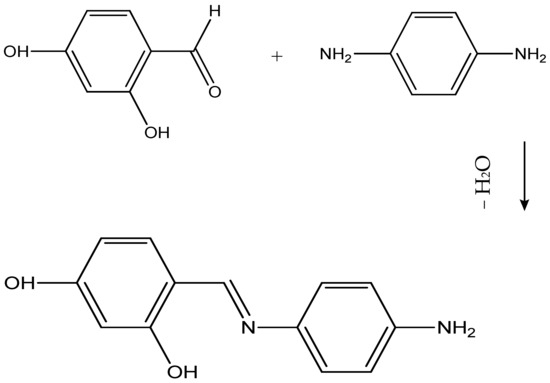
Scheme 1.
Synthesis of the ligand HL.
(E)-4-(((4-aminophenyl)imino)methyl)benzene-1,3-diol (HL): Orange precipitate. Yield: (72%). M.p.:223 °C. Elemental analysis data for C13H12N2O2 (FW = 228.25); Calculated: C: 68.41, H: 5.30, N: 12.27. Found: C: 68.10, H: 5.22, N: 12.11. IR: ν(C=N); 1626 cm−1, ν(NH2-OH); 3294-3359 cm−1, ν(OH); 3443 cm−1. UV-Vis (DMF) λ max (nm): 311, 370. 1H NMR (DMSO-d6) δ ppm: 5.26 (NH2), δ: 6.26- 7.45 (7H, Ar-H), δ: 8.68 (1H, CH), δ: 10.10 (1H, para phenolic OH), and δ: 14.08 (1H, ortho phenolic OH). 13C NMR (DMSO-d6) δ ppm: 163.2 (ortho C-O), δ: 161.8 (para C-O), δ: 157.66 (HC=N), δ: 148.3 (C-NH2), and δ: 102.8–133.7 aromatic carbons.
2.4. Synthesis of Transition Metal Complexes (1–4)
We added 0.457 g (2 mmol) of HL in 30 mL ethanol to metal salt (2 mmol)—namely, CuCl2·2H2O, CoCl2·6H2O, NiCl2·6H2O, or ZnCl2 dry; dissolved in the least amount of bi-distilled water. The mixture was left to stir under reflux for 10 h to ensure complete formation. The precipitate was filtered and washed several times with an ethanol-water mixture of 50% (v/v) to remove any unreacted reactants. Then, the precipitate was dried in anhydrous CaCl2. The obtained complexes are [Co L Cl (H2O)2] (1), [Ni L Cl (H2O)3]·H2O (2), [Cu L Cl (H2O)3]·H2O (3), and [Zn L Cl (H2O)2]·H2O (4). The chemical structure of the synthesized complexes is represented in Scheme 2.
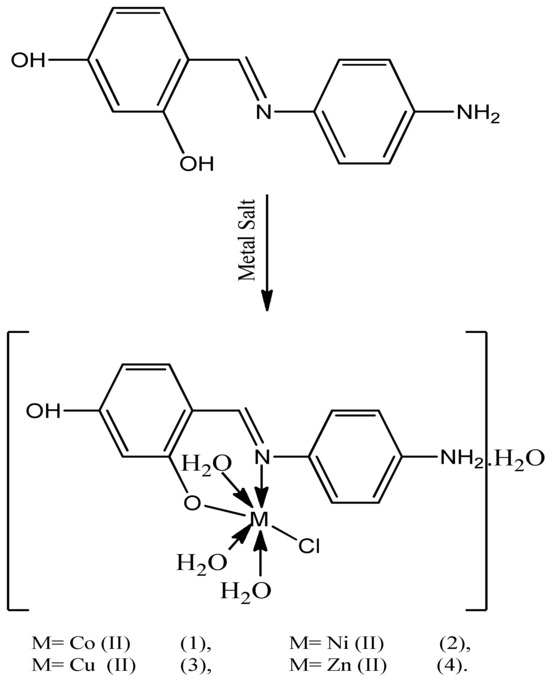
Scheme 2.
Synthesis of the metal complexes (1–4).
Co (II) Complex (1): Dark Brown Precipitate. Yield: (83%). M.p.:270 °C. Elemental analysis data for C13H19 Cl Co N2O6 (FW = 393.7); Calculated: C: 39.66, H: 4.86, N: 7.12. Found: C: 39.38, H: 4.24, N: 6.98. IR: ν(C=N); 1611 cm−1, ν(NH2-OH); 3142-3223cm- 1, ν(M-O); 589 cm−1, ν(M-N); 534 cm−1. UV-Vis (DMF) λ max (nm): 224, 307, 481.
Ni (II) Complex (2): Red Brown Precipitate. Yield: (90%). M.p.:254°C. Elemental analysis data for C13H19 Cl Ni N2O6 (FW = 393.45); Calculated: C: 39.68, H: 4.87, N: 7.12. Found: C: 39.50, H: 4.62, N: 7.09. IR: ν(C=N); 1619 cm−1, ν(NH2-OH); 3223-3251 cm−1, ν(M-O); 592 cm−1, ν(M-N); 541 cm−1. UV-Vis (DMF) λ max (nm): 229, 317, 452.
Cu (II) Complex (3): Black Precipitate. Yield: (76%). M.p.: 298 °C. Elemental analysis data for C13H19 Cl Cu N2O6 (FW= 398.3); Calculated: C:39.20, H:4.81, N:7.03. Found: C:38.99, H:3.24 N:7.01. IR: ν(C=N); 1622 cm−1, ν(NH2- OH); 3166-3250 cm−1, ν(M-O); 591cm−1, ν(M-N); 543 cm−1. UV-Vis (DMF) λ max (nm): 219, 306, 464.
Zn (II) Complex (4): Pale Brown Precipitate. Yield: (73%). M.p.: 290 °C. Elemental analysis data for C13H19 Cl Zn N2O6 (FW = 400.1); Calculated: C: 39.02, H: 4.79, N: 7.00. Found: C: 38.87, H: 4.54, N: 6.82. IR: ν(C=N), 1620 cm−1, ν(NH2- OH); 3263-3300 cm−1, ν(M-O); 585 cm−1, ν(M-N); 523 cm−1. UV-Vis (DMF) λ max (nm):233, 320, 380. 1HNMR (DMSO-d6) δ: 5.29 (NH2), δ: 6.25- 7.44 (7H, Ar-H), δ: 8.66 (1H, CH), δ: 10.07 (1H, para phenolic OH). 13CNMR (DMSO-d6) δ ppm: 164.34 (ortho C-O), δ: 162 (para C-O), δ: 157.63 (HC=N), δ: 148.3 (C-NH2), and δ: 102.8-137 aromatic carbons.
2.5. Coating Techniques
Different two coating techniques were used for modification of the cotton fabric, and these techniques are represented in Figure 1a,b.
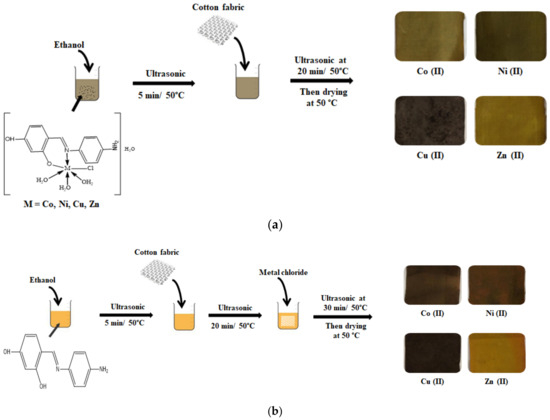
Figure 1.
Photographic images of cotton fabric treated with Schiff base metal under two different techniques (a) Technique 1 and (b) Technique 2 (in situ formation).
2.5.1. Coating of Cotton Fabric by the Previously Synthesized Ligand or the Metal Complexes (Technique 1-T1)
As presented in Figure 1a, the mixture of 0.1 g of the synthesized ligand (or the complex) was dissolved in 30 mL of ethanol and sonicated for 5 min at 50 °C. We immersed 1 gm of cotton fabric in the prepared mixture and sonicated for 20 min. Then, we dried the samples at 50 °C for 10 min. Finally, the samples were washed with deionized water several times and dried.
2.5.2. In Situ Formation of Nanometal Complexes Schiff Base Coated Cotton Fabric (Technique 2-T2)
The in situ formation of Schiff base, Co complex is illustrated in Figure 1b; 0.1 g of the synthesized ligand was dissolved in 30 mL of ethanol under sonication for 5 min at 50 °C. Then, 1 gm of cotton fabric was immersed in the previous mixture with continuous sonication for 20 min. After that, 0.1 g of the CoCl2·6H2O was added to the solution mixture and sonicated for 30 min. Finally, the sample was washed with deionized water several times and dried. The in situ Ni, Co, and Zn complexes were synthesized with the same method.
2.6. Instruments
1H and 13C nuclear magnetic resonance (NMR) spectroscopies for the ligand and its diamagnetic complexes were performed using a Bruker spectrometer (Billerica, MA, USA) at 850 MHz; the used solvent was DMSO, the standard reference was tetramethylsilane, and the temperature of the probe was 25 °C. The FTIR spectra of the ligand, complexes, the cotton fabric samples were measured using an Agilent spectrometer (Cary 600 FTIR, Santa Clara, CA, USA), which was operated in the wavenumber range of 4000–400 cm−1.
A Shimadzu UV-Vis spectrophotometer (UV-1650PC, Kyoto, Japan) was used to measure dimethylformamide (DMF) solutions (1 × 10−3 M) of the ligand and their metal complexes. A Vario EL M, Hanau, Germany was used to measure the CHN contents of the ligand and its complexes. A Shimadzu simultaneous TG apparatus (DTG-60AH, Kyoto, Japan) was used in the air with a heating rate of 10 °C/min; from (room temperature −700 °C) range was used. A Rigaku XRD diffractometer was used to measure the samples’ XRD patterns (Ultima IV, Tokyo, Japan; using Cu Kα radiation (λ = 1.54180 Å).
The molar conductivity of (1 × 10−3 M) of samples dissolved in DMSO of the metal complexes at room temperature was measured using an Oakton (CON 700, Singapore) Conductivity meter. The Magnetic Susceptibility Balance—Auto (Sherwood Scientific, Cambridge, UK) was used to measure the magnetic susceptibility of the prepared solid metal complexes at room temperature. The used ultrasonic water base is a Wise Clean ultrasonic bath (WUC-D22H, Wertheim, Germany, frequency of 40 kHz, power input of 300 W).
The studies of electron microscopy were undertaken using JEOL -JEM-1230 transmission electron microscopy (TEM) (with a 40–120 kV accelerating voltage, Tokyo, Japan) and scanning electron microscopy (SEM) (Tescan Vega3) with an attached energy dispersive X-ray spectrometer (EDX) Model vega3 (Brno, Czech Republic). SEM samples were prepared on an appropriate disc and coated with gold to make the samples conductive to electrons.
2.7. Antimicrobial Activity
The biological activities of treated cotton samples were studied for antibacterial and antifungal properties using the disc diffusion method. Different types of bacteria Staphylococcus aureus (S. aureus) as Gram-positive and Escherichia coil (E. coli) as Gram-negative were used. Candida albicans (C. albicans) and Aspergillus flavus for fungus. S.aureus, E. coil, C. albicans, and Aspergillus flavus originated from ATCC12600, ATCC11775, ATCC 7102, and ATCC 9643, respectively. The antibacterial and antifungal properties were studied by the disc diffusion method.
2.8. Tensile Strength
The ASTM Test Method (D-1682-94, 1994) was used to determine the tensile strength of the cotton samples.
2.9. The Add-On (%) Loading
The add-on (%) loading was calculated as follows:
where W1 and W2 are the weights of the fabric specimens before and after treatment, respectively.
2.10. UV Protection Factor
Ultraviolet protection factor (UPF) was measured using UV Shimadzu 3101 Spectrophotometer. UV protection and classification according to AS/NZS 4399:1996 were evaluated with a scan range was of 200–600 nm.
2.11. Durability Test
To evaluate the UPF protection values’ durability to washing, the treated cotton samples were subjected to ten laundry cycles according to the ASTM standard test procedure (D 737-109 96).
2.12. Statistical Analysis
The results of add-on% and tensile strength values were expressed as follows: the mean of the repeating of each sample three times (n = 3) with its standard deviation (the mean ± S.D.).
3. Result and Discussion
3.1. Ligand and Its Metal Complexes Characterization
The Supplementary Materials describe the detailed characterization of the ligand metal complexes and the energy dispersive X-ray analysis of the modified cotton. This section will discuss the main characteristics of the complexes and their interactions with the cellulosic fibers.
UV-Visible Spectroscopy and Magnetic Susceptibility
Table 1 represent UV-visible spectroscopy and magnetic susceptibility of Schiff base ligand and its complexes. The electronic spectra of the Schiff base ligand and its complexes were recorded in dimethylformamide (DMF) solvent within the wavelength range of 200–700 nm. The electronic spectrum of the ligand is characterized by its absorption bands at 311 and 370 nm. The highest energy band (lower wavelength) is assigned to π–π* transitions, while the lowest energy bands can be assigned to n–π* transitions [29,30].

Table 1.
UV–Vis spectral data of the ligand and its metal complexes and magnetic moment.
As illustrated in Figure 2, Co (II) complex (1) shows an absorption spectrum at 481 nm. as a result of d-d transition for 4T1g → 4T2g (P) [31]. The magnetic moment value of Co (II) complex equals 3.99 B.M. the low value may be due antiferromagnetic spin–spin interaction between cobalt (II) ions (d7) through molecular association, which is in agreement with the values of Co (II) octahedral geometry [30,31,32].
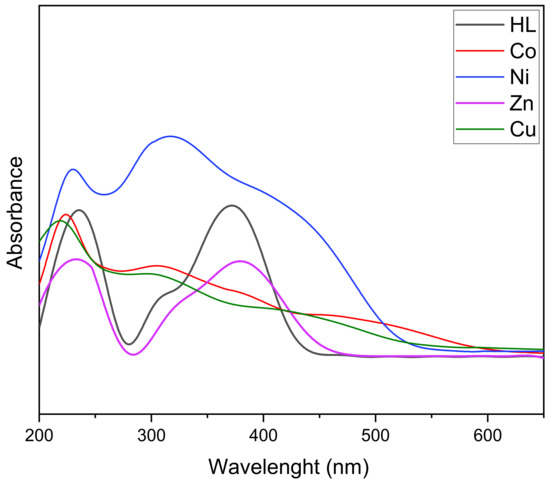
Figure 2.
UV-Vis spectrum of the ligand and its metal complexes.
The absorption spectrum of Ni (II) complex (2) shows a band at 452 nm. as a result of d-d transition for 3A2g ⟶ 3T2g [33]. The magnetic moment value of Ni (II) complex 2.7 BM confirms the presence of two unpaired electrons in the octahedral geometry [34].
The electronic absorption spectrum of Cu (II) complex (3) shows two bands at 464 and 620 nm. The first is assigned to the 2B1 → 2Eg transition, while the second is very weak and broad centered at 620 nm. The position and the broadness of this band indicated to tetragonally distorted octahedral geometry around the copper (II) ion. This broad band may consist of three superimposed transitions 2B1g → 2A1g, 2B1g → 2A1g, and 2B1g → 2B2g [16,20]. The magnetic moment value of Cu (II) complex is 1.60 BM, which suggests an octahedral geometry around the Cu (II) [35].
The electronic absorption spectrum of Zn (II) complex (4) shows a band at 380 nm, assignable to the metal to ligand charge transfer (MLCT) transition. Finally, the Zn (II) complex showed a diamagnetic value [35].
3.2. Characterizations of Cotton Fabric
3.2.1. Fourier Transform Infrared Spectroscopy (FTIR) Spectra
The FTIR spectrum gives an idea about the functional groups present in the macromolecules before and after the structural modification reaction. Figure 3 indicates the FTIR spectrum of modified cotton fabric by ligand and its metal complexes via technique 1 and technique 2. Figure 3 (T2, T1) indicates the FTIR spectrum of blank cotton fabric. A broad band appears around 3320 cm−1, which can be attributed to (O–H) stretching. The existence of (C–H), (C–O), (O–H), and (C–O–C) vibrations produced the characteristic bands in the range of 1500–800 cm−1. The C- H symmetric and antisymmetric stretching was observed at 2843 and 2904 cm−1, respectively [36,37].
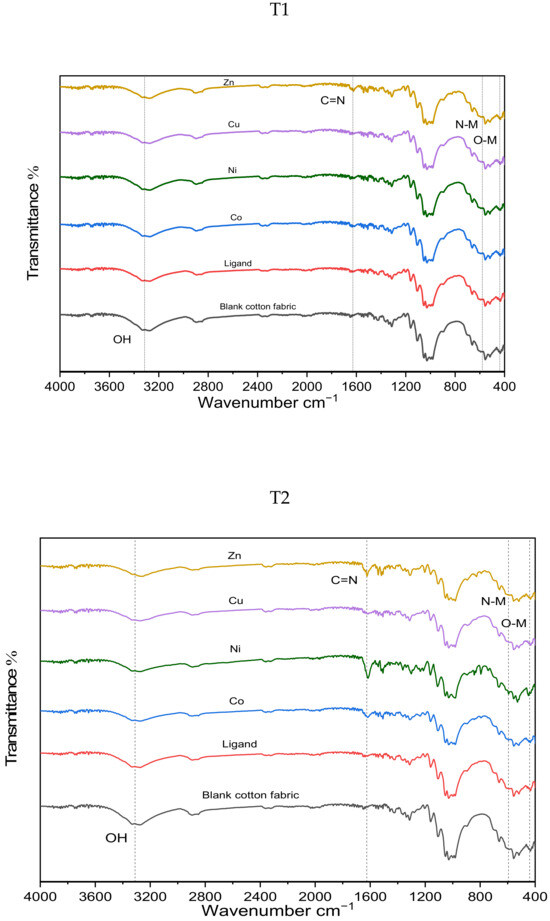
Figure 3.
FTIR spectrum of unmodified and modified cotton fabric with ligand and their metal complexes via, (T2) technique 2 (in situ) and (T1) technique 1.
Furthermore, the spectra of all treated cotton fabrics showed distinctive peaks related to cellulose structure, as well as the addition of absorption peaks. According to Figure 3 (T2, T1), the stretching vibrations (C=N), and (N-M) (Nitrogen-Metal) were obtained for the structural conformation of ligands and their respective metal complexes modified cotton fabric. The FTIR bands were found to be slightly shifted for modified fabrics as indicated by the stretching data of functional groups of the complexes mentioned in Table S2 (Supplementary Materials).
In Figure 3 (T2), the band of (C=N) for ligand appeared at 1645 cm−1, which is a distinctive characteristic feature of Schiff bases. After complexation, the peak of (C=N) was shifted towards the lower frequency, i.e., 1621 cm−1 for Co (II) and Ni(II), 1625 cm−1 for Zn(II) and Co (II) [38]. It was noticed from Figure 3 (T2), that the broader O-H band for cotton-modified ligand and their nano metal complexes.
This may be due to the intermolecular hydrogen bond between terminal NH2 and OH groups of Schiff base and primary (OH) groups of cellulosic cotton fabric [39] as shown in Figure 4. The weak peaks at 590 and 455 cm−1 are slightly shifted comparing with the blank cotton fabric are attributed to interactions between N-M (Nitrogen-Metal) and O-M (Oxygen-Metal) suggesting that coordination has occurred during the modification of cotton fabric [40]. In a similar way to technique 2, the same absorption peaks were observed in technique 1 but with weaker intensity than technique 1.
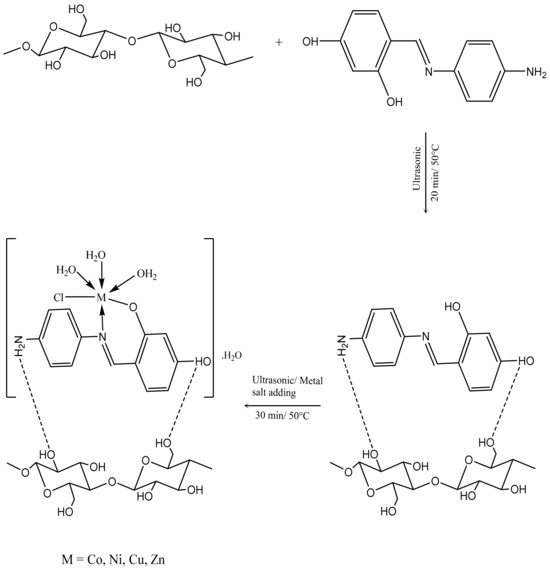
Figure 4.
Schematic mechanism for deposition of Schiff base ligand metal complex on the surface of cotton fabric.
3.2.2. XRD of the Modified Cotton
The crystalline structure of the unmodified/modified cotton fabrics was measured by XRD diffractometer. The XRD of fabric samples of the two techniques are represented in Figure 4. The diffraction peaks are detected at 2θ values of 15.2°, 16.7°, 23.1°, and 34.7° related to the cellulose crystalline structure of all the samples [41].
XRD of the modified cotton fabric in the case of in situ formation (T2), and the fabric coated with the previously synthesized complexes (T1) was investigated. The appearance of the new peaks at 2θ value around 21°. As shown in Figure 5, the 2θ peak values in situ (L = 21°, Co = 20.6°, Ni = 20.8°, Cu = 20.7°, and Zn = 20.8°). The missing of this peak in the blank cotton fabric can be an indication of the successful interaction between the cellulose chain of cotton fabric with the ligand and its metal complexes.
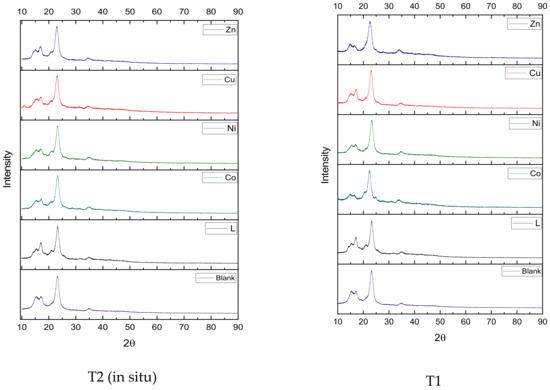
Figure 5.
XRD analysis of unmodified and modified cotton fabric with ligand and their metal complexes via, (T2) technique 2 and (T1) technique 1.
The peak of 2θ value around 21° in technique 2 (in situ) is more intense than in technique 1, and this may be due to the nano size causing more cutting of the cellulose crystalline structure. This interaction between cellulose and ligand or its metal complexes is due to the hydrogen bond formation. The interaction was formed by cutting off the cellulosic intermolecular hydrogen bond and formation of a new hydrogen bond between N and O (terminal –OH and–NH2 of ligand or its metal complexes) and the hydrogen atom of the primary –OH groups of the cellulosic fabric [39,42,43].
3.2.3. SEM of Nanometal Complex Modified Cotton Fabric:
SEM analysis of the cotton fabrics was used to characterize the changes in the surface morphology of the surface of cotton fabric [44]. Figure 6a–f are the SEM of the blank cotton fabric, ligand, and nanometal complexes Schiff base treated cotton fabric, respectively. In Figure 6a, the blank cotton exhibits a smooth and flat surface structure. In contrast, the surface of cotton fabric coated with ligand in Figure 6b has fine particles and the surface represents more rough. In comparing to figures (a and b), figures (c, d, e, and f) represented the increase in surface roughness on the surface of the coated cotton fabrics. This result is evidenced by the successful deposition of all metal-complexes Schiff base on the surface of cotton fabrics.
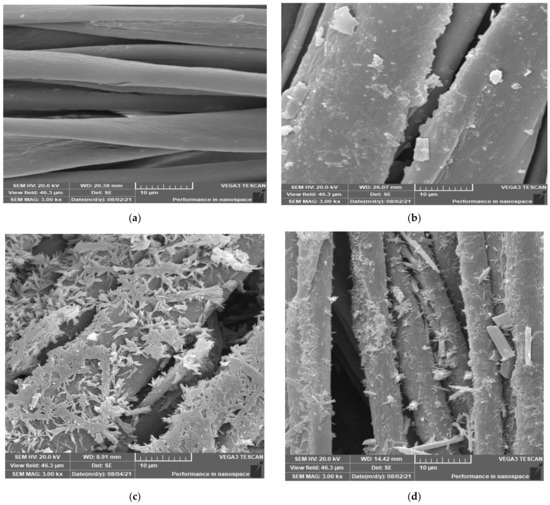
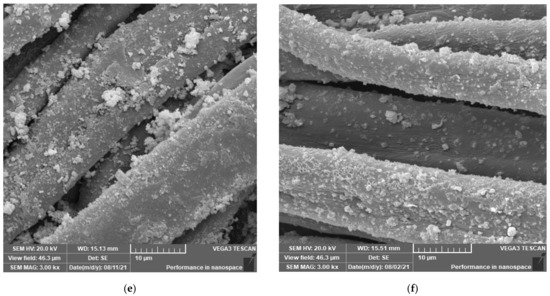
Figure 6.
SEM images of (a) blank cotton fabric, (b) ligand modified cotton fabric, (c) Co-complex Schiff-base-modified cotton fabric, (d) Ni-complex Schiff-base-modified cotton fabric, (e) Cu-complex Schiff-base-modified cotton fabric, and (f) Zn-complex Schiff-base-modified cotton fabric.
3.2.4. Antimicrobial Properties
Antimicrobial activities of synthesized HL modified cotton fabric and its metal Nano complexes modified cotton fabric via technique 1 and technique 2 were studied for antibacterial and antifungal properties by disc diffusion method. The results were recorded by measuring the growth inhibition (zone of inhibition) surrounding the disc of the fabric. The result mentioned in Table 2 and Figure 7 indicated the antimicrobial effect for all treatments is ranging from 13 to 31 mm of a clear zone of inhibition depending on the type of metal complex used.

Table 2.
Antimicrobial efficiency of unmodified cotton fabric, ligand, and ligand metal.
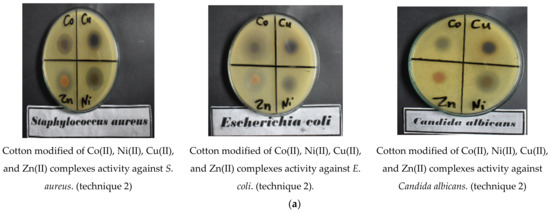
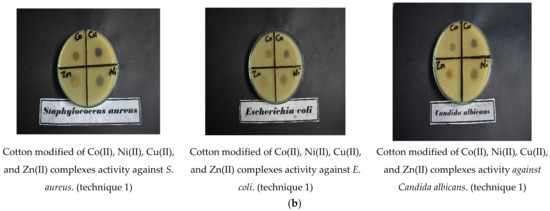
Figure 7.
Images of antimicrobial results of modified cotton fabric by nanometal complexes of Co(II), Ni(II), Cu(II), and Zn(II) (a) Technique 2 and (b) Technique 1.
Cotton modified ligand (HL) has a weak effect on bacteria species and is not effective on fungus species. Ligand metal complexes modified cotton fabric (from technique 1) show moderate effect against S. aureus and E. coli bacteria except for Co (II) complex modified cotton fabric has no effect. This may be due to variations in bacterial cell wall organization structure. On the other hand, all the metal complexes modified cotton fabrics have no effect against both Candida albicans and Aspergillus flavus except Ni (II) complex modified cotton fabric.
In comparing with technique 1, nanometal complexes modified cotton fabric (from technique 2) show high activity against both bacteria S. aureus and E. coli. In addition, Co (II) and Ni (II) nanometal complexes modified cotton fabric show good efficiency against Candida albicans but Cu (II) nanometal complexes give weak activity and Zn (II) has no effect. All nanometal complexes modified cotton fabric show no effect against Aspergillus flavus.
The higher inhibition zone of ligand metal complex and nanometal complexes modified cotton fabric may be due to using the metal chloride and nanosize effect. It also can be described according to the chelation theory and Overton’s concept. Overton’s concept of cell permeability described that the lipid membrane surrounding the cell favors the passage of only lipid-soluble materials due to which liposolubility is an important factor that controls the antimicrobial activity.
According to chelation theory, when metal ion chelates with its ligand, the polarity will be lowered to a higher extent because of the ligand orbital overlapping with the partial sharing of the metal ion positive charge with the donor groups. This also increases the delocalization of p-electrons across the whole chelate ring, which increases the lipophilicity of metal complexes. This increased lipophilicity enhances the penetration of complexes into lipid membrane and restricts the further multiplicity of microorganisms. The metal complexes also affect the respiration procedure of the cell; hence, they block the synthesis of proteins, which prevents the further growth of organisms [45,46].
The effectiveness variation of different compounds against different microorganisms is determined by the impermeability of microorganisms’ cells or by differences in ribosome of microbial cells. The results also depict that nanometal complexes modified cotton fabric give higher activity against bacteria and fungus compared with metal–ligand complexes coated cotton fabric. As illustrated from XRD and TEM analysis, all the complexes’ crystal sizes are in the nano-domain. This nano character of the prepared complexes increased the antimicrobial activity via facilitating penetration of nano-complexes into the microbial cell [47]. The results of antibacterial demonstrated that the modified cotton fabric with nanometal complexes will have potential applications in biomaterial and textile fields.
3.2.5. UV Blocking
UPF values were measured to determine the UV-radiation protection characteristics of untreated cotton fabrics and nano metal complexes modified fabrics. Three types of protection can be found in textile materials, according to BS EN 13758-2: 2003: the excellent protection (UPF range > 40), very good (UPF range 30–40), and good protection (UPF range 20–29) [37]. According to the results in Table 3, the calculated UPF value of unmodified cotton fabric is 4.5. The calculated UPF value for nano complexes modified cotton fabric is varied from 93.5 to 507.5, which is higher than for the unmodified fabric.

Table 3.
UPF values of cotton fabric modified with ligand and its nanometal complexes.
The ligand modified cotton fabric has a 117.5 UPF value. On the other hand, there is a significant increase in UPF values after the formation of nanometal complexes on cotton fabric. It was noticed from the results in Table 3 that the value of UPF is varied according to the type of metal used. The values of UPF of nanometal complexes modified cotton fabric follow the order: Cu (II) > Ni (II) > Co (II) > Zn (II). The improving performance of ligand modified cotton fabric and its nanometal complexes modified fabric could be attributed to π–π* and n–π* transitions of the conjugated system [26].
The data of Table 3 shows the durability of the product during washing cycles. According to the obtained results, raising the number of washing cycles to 10 caused a small decrease in the UPF values of the washed modified fabrics, and the fabric maintained excellent rating. By this, we still have the protective property after several washing cycles. This confirms the strong bending of nanometal complexes based on Schiff-base-modified cotton fabric.
3.2.6. The Add-On (%) Loading and Tensile Strength
Table 4 shows the percentage of the values for add-on measurements and the mechanical properties of chemically modified cotton fabric via two techniques used. The amount of chemicals deposited on the cotton fabric during modification is indicated by the add-on values. As presented in Table 4, the add-on values via technique 2 are higher than the values via technique 1. The results present that the add–on values for modified cotton fabric with the ligand is 2.01%, whereas a significant increase in add-on values varied from 3.71% to 6.99% for nanometal complexes modified fabrics via technique 2. Table 4 also demonstrated the add-on values varied from 0.94% to 2.63% for metal complexes modified cotton fabrics via technique 1. In contrast, Table 4 shows that there is a significant decrease in the values of tensile strength for both techniques are used. This may be attributed to the varied modification of cotton fabric.

Table 4.
Add–on measurements and tensile strength of the treated cotton fabric.
4. Conclusions
Co(II), Ni(II), Cu(II), and Zn(II) complexes from Schiff base (E)-4-(((4-aminophenyl)imino)methyl)benzene-1,3-diol (HL) were successfully prepared. The structural features of metal complexes have been proven. The ligand acts as monobasic bidentate. The stoichiometry of the metal complexes is a 1:1 ratio with the general formula [M L Cl (H2O)3] H2O. The magnetic susceptibility and UV-visible spectroscopy results support that Co(II), Ni(II), Cu(II), and Zn(II) complexes have octahedral geometry. The synthesized complexes from the Schiff base were also successfully deposited on the surface of cotton fabric by the different two techniques of modification. Technique 2 (the in situ formation of nano complexes) showed high efficiency against antimicrobial activity and durable UV protection properties compared with technique 1.
The study revealed that the modification of the cotton with metal complexes caused enhancement in antimicrobial properties with simultaneous improvement in the UV protective properties of the fabrics. The increased antibacterial properties of the modified fabrics may be attributed to the effect of the metal chelation theory. The modified cotton fabric showed acceptable antifungal against Candia albicans especially in the case of Co (II) and Ni (II) complexes. The improvement of the UV protection values as a result to π–π* and n–π* transition of the ligand and its metal complexes.
After the washing cycles, all the modified cotton fabric with metal complexes maintained UV protection properties. The results revealed that Schiff base divalent Co, Ni, Cu, and Zn complexes are multifunctional textile finishes that could be promising as industrial textile products.
Supplementary Materials
The following supporting information can be downloaded at: https://www.mdpi.com/2079-6412/12/8/1181/s1, Figure S1: 1H NMR of Ligand (a) and Zn (II) complex (b); Figure S2: 13C NMR of Ligand (a) and Zn (II) complex (b); Figure S3. IR analysis of the ligand and its complexes. Figure S4. S: XRD pattern of the ligand and its metal complexes. Figure S5. TEM images of nano complexes (a) Co(II), (b) Ni(II), (c) Cu(II), and (d) Zn(II). Figure S6. EDX analysis of unmodified and modified cotton fabric (a) blank cotton fabric, (b) ligand modified cotton fabric, (c) Co-complex Schiff base modified cotton fabric, (d) Ni-complex Schiff base modified cotton fabric, (e) Cu-complex Schiff base modified cotton fabric, and (f) Zn-complex Schiff base modified cotton fabric. Table S1. Analytical data of ligand and metal complexes; Table S2. FTIR spectral data of the ligand and its metal complexes; Table S3. TGA data of the metal complexes; Table S4. The unit cell parameters and crystal data of the ligand and metal complex.
Author Contributions
Conceptualization, S.E.-S.S., M.M.A.E.-H. and A.N.A.; methodology, S.E.-S.S. and M.M.A.E.-H.; software, S.E.-S.S., M.M.A.E.-H. and T.M.A.-H.; validation, S.E.-S.S., M.M.A.E.-H., T.M.A.-H. and A.N.A.; formal analysis, S.E.-S.S., M.M.A.E.-H. and T.M.A.-H.; investigation, S.E.-S.S., M.M.A.E.-H. and T.M.A.-H.; resources, S.E.-S.S., M.M.A.E.-H., T.M.A.-H. and A.N.A.; data curation, S.E.-S.S., M.M.A.E.-H. and T.M.A.-H.; writing—original draft preparation, S.E.-S.S., M.M.A.E.-H. and T.M.A.-H.; writing—review and editing, S.E.-S.S., M.M.A.E.-H. and T.M.A.-H.; visualization, S.E.-S.S., M.M.A.E.-H., T.M.A.-H. and A.N.A.; supervision, S.E.-S.S., M.M.A.E.-H. All authors have read and agreed to the published version of the manuscript.
Funding
This research received no external funding.
Institutional Review Board Statement
Not applicable.
Informed Consent Statement
Not applicable.
Data Availability Statement
The data used to support the findings of this study are included within the article.
Conflicts of Interest
The authors declare no conflict of interest.
Correction Statement
This article has been republished with a minor correction to the existing affiliation information. This change does not affect the scientific content of the article.
References
- Küçük, M.; Öveçoğlu, M.L. Fabrication of SiO2–ZnO NP/ZnO NR hybrid coated cotton fabrics: The effect of ZnO NR growth time on structural and UV protection characteristics. Cellulose 2020, 27, 1773–1793. [Google Scholar] [CrossRef]
- Chen, W.; Zhu, Y.; Zhang, Z.; Gao, Y.; Liu, W.; Borjihan, Q.; Qu, H.; Zhang, Y.; Zhang, Y.; Wang, Y.-J.; et al. Engineering a multifunctional N-halamine-based antibacterial hydrogel using a super-convenient strategy for infected skin defect therapy. Chem. Eng. J. 2020, 379, 122238. [Google Scholar] [CrossRef]
- Liu, J.; Dong, C.; Wei, D.; Zhang, Z.; Xie, W.; Li, Q.; Lu, Z. Multifunctional Antibacterial and Hydrophobic Cotton Fabrics Treated with Cyclic Polysiloxane Quaternary Ammonium Salt. Fibers Polym. 2019, 20, 1368–1374. [Google Scholar] [CrossRef]
- Shirvan, A.R.; Kordjazi, S.; Bashari, A. Environmentally friendly Finishing of Cotton Fabric via Star-like Silver micro/nano Particles Synthesized with Neem/Salep. J. Nat. Fibers 2021, 18, 1472–1480. [Google Scholar] [CrossRef]
- Sharaf, S.; Farouk, A.; El-Hady, M. Novel conductive textile fabric based on polyaniline and CuO nanoparticles. Int. J. PharmTech Res. 2016, 9, 461–472. [Google Scholar]
- Abd El-Hady, M.M.; Farouk, A.; Sharaf, S. Multiwalled-Carbon-Nanotubes (MWCNTs)–GPTMS/Tannic-Acid-Nanocomposite-Coated Cotton Fabric for Sustainable Antibacterial Properties and Electrical Conductivity. Coatings 2022, 12, 178. [Google Scholar] [CrossRef]
- Abd El-Hady, M.M.; Saeed, S.E.S. Antibacterial properties and pH sensitive swelling of insitu formed silver-curcumin nanocomposite based chitosan hydrogel. Polymers 2020, 12, 2451. [Google Scholar] [CrossRef] [PubMed]
- Farouk, A.; Saeed, S.E.-S.; Sharaf, S.; El-Hady, M.M.A. Photocatalytic activity and antibacterial properties of linen fabric using reduced graphene oxide/silver nanocomposite. RSC Adv. 2020, 10, 41600–41611. [Google Scholar] [CrossRef] [PubMed]
- Abd El-Hady, M.M.; Farouk, A.; Saeed, S.E.S.; Zaghloul, S. Antibacterial and UV Protection Properties of Modified Cotton Fabric Using a Curcumin/TiO2 Nanocomposite for Medical Textile Applications. Polymers 2021, 13, 4027. [Google Scholar] [CrossRef] [PubMed]
- Laddha, P.R.; Biyani, K.R. Synthesis and Biological Evaluation of Novel Schiff Bases of Aryloxy Moiety. J. Drug Deliv. Ther. 2019, 9, 44–49. [Google Scholar] [CrossRef]
- Raczuk, E.; Dmochowska, B.; Samaszko-Fiertek, J.; Madaj, J. Different Schiff Bases—Structure, Importance and Classification. Molecules 2022, 27, 787. [Google Scholar] [CrossRef] [PubMed]
- Thangadurai, T.D.; Gowri, M.; Natarajan, K. Synthesis and characterization of ruthenium (III) complexes containing monobasic bidentate Schiff bases and their biological activities. Synth. React. Inorg. Met. Org. Chem. 2002, 32, 329–344. [Google Scholar] [CrossRef]
- Ramesh, R.; Sivagamasundari, M. Synthesis, spectral and antifungal activity of Ru (II) mixed-ligand complexes. Synth. React. Inorg. Met. Org. Chem. 2003, 33, 899–910. [Google Scholar] [CrossRef]
- Shahid, K.; Ali, S.; Shahzadi, S.; Badshah, A.; Khan, K.M.; Maharvi, G.M. Organotin (IV) complexes of aniline derivatives. I. Synthesis, spectral and antibacterial studies of di-and triorganotin (IV) derivatives of 4-bromomaleanilic acid. Synth. React. Inorg. Met. Org. Chem. 2003, 33, 1221–1235. [Google Scholar] [CrossRef]
- Rauf, A.; Shah, A.; Munawar, K.S.; Ali, S.; Tahir, M.N.; Javed, M.; Khan, A.M. Synthesis, physicochemical elucidation, biological screening and molecular docking studies of a Schiff base and its metal (II) complexes. Arab. J. Chem. 2020, 13, 1130–1141. [Google Scholar] [CrossRef]
- Alorini, T.A.; Al-Hakimi, A.N.; Saeed, S.E.-S.; Alhamzi, E.H.L.; Albadri, A.E. Synthesis, characterization, and anticancer activity of some metal complexes with a new Schiff base ligand. Arab. J. Chem. 2020, 15, 103559. [Google Scholar] [CrossRef]
- Saeed, S.E.S.; Alhakimi, A.N. Synthesis, characterization of Lanthanum mixed ligand complexes based on benzimidazole derivative and the effect of the added ligand on the antimicrobial, and anticancer activities. J. Nat. Sci. Math. (JNSM) 2022, 15, 35–53. [Google Scholar]
- da Silva, C.M.; da Silva, D.L.; Modolo, L.; Alves, R.B.; de Resende, M.A.; Martins, C.V.; de Fátima, Â. Schiff bases: A short review of their antimicrobial activities. J. Adv. Res. 2011, 2, 1–8. [Google Scholar] [CrossRef]
- Naureen, B.; Miana, G.A.; Shahid, K.; Asghar, M.; Tanveer, S.; Sarwar, A. Iron (III) and zinc (II) monodentate Schiff base metal complexes: Synthesis, characterisation and biological activities. J. Mol. Struct. 2021, 1231, 129946. [Google Scholar] [CrossRef]
- Fouda, M.F.R.; Abd-Elzaher, M.M.; Shakdofa, M.M.E.; El Saied, F.A.; Ayad, M.I.; El Tabl, A.S. Synthesis and characterization of transition metal complexes of N′-[(1,5-dimethyl-3-oxo-2-phenyl-2,3-dihydro-1H-pyrazol-4-yl) methylene] thiophene-2-carbohydrazide. Transit. Met. Chem. 2008, 33, 219–228. [Google Scholar] [CrossRef]
- El-Molla, M.M.; Shama, S.A.; Saeed, S.E.-S. Preparation of Disappearing Inks and Studying the Fading Time on Different Paper Surfaces. J. Forensic Sci. 2013, 58, 188–194. [Google Scholar] [CrossRef] [PubMed]
- Saeed, S.E.S.; El-Molla, M.M.; Hassan, M.L.; Bakir, E.; Abdel-Mottaleb, M.M.; Abdel-Mottaleb, M.S. Novel chitosan-ZnO based nanocomposites as luminescent tags for cellulosic materials. Carbohydr. Polym. 2014, 99, 817–824. [Google Scholar] [CrossRef]
- Shama, S.; El-Molla, M.; Basalah, R.F.; Saeed, S.E.-S. Fading Time Study on Prepared Thymolphthalein, Phenolphthalein and their Mixture Disappearing Ink. Res. J. Text. Appar. 2008, 12, 9–18. [Google Scholar] [CrossRef]
- Abdel-Rahman, L.H.; El-Khatib, R.M.; Nassr, L.A.; Abu-Dief, A.M. Synthesis, physicochemical studies, embryos toxicity and DNA interaction of some new Iron (II) Schiff base amino acid complexes. J. Mol. Struct. 2013, 1040, 9–18. [Google Scholar] [CrossRef]
- Abu-Dief, A.M.; Mohamed, I.M. A review on versatile applications of transition metal complexes incorporating Schiff bases. Beni-Suef Univ. J. Basic Appl. Sci. 2015, 4, 119–133. [Google Scholar] [CrossRef] [PubMed]
- Hou, A.; Zhang, C.; Wang, Y. Preparation and UV-protective properties of functional cellulose fabrics based on reactive azobenzene Schiff base derivative. Carbohydr. Polym. 2012, 87, 284–288. [Google Scholar] [CrossRef]
- Sharma, V.; Ali, S.W. A greener approach to impart multiple functionalities on polyester fabric using Schiff base of vanillin and benzyl amine. Sustain. Chem. Pharm. 2022, 27, 100645. [Google Scholar] [CrossRef]
- Wen, W.; Zhang, Z.; Jing, L.; Zhang, T. Highly Antibacterial Efficacy of a Cotton Fabric Treated with Piperazinyl Schiff Base. Fibers Polym. 2021, 22, 3298–3308. [Google Scholar] [CrossRef]
- Valarmathy, G.; Subbalakshmi, R.; Sumathi, R.; Renganathan, R. Synthesis of Schiff base ligand from N-substituted benzenesulfonamide and its complexes: Spectral, thermal, electrochemical behavior, fluorescence quenching, in vitro-biological and in-vitro cytotoxic studies. J. Mol. Struct. 2020, 1199, 127029. [Google Scholar] [CrossRef]
- Daravath, S.; Vamsikrishna, N.; Ganji, N.; Venkateswarlu, K. Synthesis, characterization, DNA binding ability, nuclease efficacy and biological evaluation studies of Co (II), Ni (II) and Cu (II) complexes with benzothiazole Schiff base. Chem. Data Collect. 2018, 17, 159–168. [Google Scholar] [CrossRef]
- El-Saied, F.A.; Shakdofa, M.M.; Abdou, S.; Abd-Elzaher, M.M.; Morsy, N. Coordination versatility of N2O4 polydentate hydrazonic ligand in Zn (II), Cu (II), Ni (II), Co (II), Mn (II) and Pd (II) complexes and antimicrobial evaluation. Beni-Suef Univ. J. Basic Appl. Sci. 2017, 6, 310–320. [Google Scholar]
- Elseman, A.; Shalan, A.E.; Rashad, M.; Hassan, A.M.; Ibrahim, N.M.; Nassar, A. Easily attainable new approach to mass yield ferrocenyl Schiff base and different metal complexes of ferrocenyl Schiff base through convenient ultrasonication-solvothermal method. J. Phys. Org. Chem. 2017, 30, e3639. [Google Scholar] [CrossRef]
- Al-Hamdani, A.A.S.; Balkhi, A.; Falah, A.; Shaker, S.A. New Azo-Schiff base derived with Ni (II), Co (II), Cu (II), Pd (II) and Pt (II) Complexes: Preparation, spectroscopic investigation, structural studies and biological activity. J. Chil. Chem. Soc. 2015, 60, 2774–2785. [Google Scholar] [CrossRef]
- Mohammed, A.; Taha, N.I. Microwave Preparation and Spectroscopic Investigation of Binuclear Schiff Base Metal Complexes Derived from 2, 6-Diaminopyridine with Salicylaldehyde. Int. J. Org. Chem. 2019, 7, 412–419. [Google Scholar] [CrossRef][Green Version]
- Mounika, K.; Pragathi, A.; Gyanakumari, C. Synthesis Characterization and Biological Activity of a Schiff Base Derived from 3-Ethoxy Salicylaldehyde and 2-Amino Benzoic acid and its Transition Metal Complexes. J. Sci. Res. 2010, 2, 513. [Google Scholar] [CrossRef]
- Meenarathi, B.; Siva, P.; Palanikumar, S.; Kannammal, L.; Anbarasan, R. Synthesis, characterization and drug release activity of poly (ε-caprolactone)/Fe3O4–alizarinred nanocomposites. Nanocomposites 2016, 2, 98–107. [Google Scholar] [CrossRef][Green Version]
- Zhang, Z.; Wang, H.; Sun, J.; Guo, K. Cotton fabrics modified with Si@ hyperbranched poly (amidoamine): Their salt-free dyeing properties and thermal behaviors. Cellulose 2021, 28, 565–579. [Google Scholar] [CrossRef]
- Samanta, B.; Chakraborty, J.; Shit, S.; Batten, S.R.; Jensen, P.; Masuda, J.D.; Mitra, S. Synthesis, characterisation and crystal structures of a few coordination complexes of nickel (II), cobalt (III) and zinc (II) with N′-[(2-pyridyl) methylene] salicyloylhydrazone Schiff base. Inorg. Chim. Acta 2007, 360, 2471–2484. [Google Scholar] [CrossRef]
- Li, N.; Ming, J.; Yuan, R.; Fan, S.; Liu, L.; Li, F.; Wang, X.; Yu, J.; Wu, D. Novel Eco-Friendly Flame Retardants Based on Nitrogen–Silicone Schiff Base and Application in Cellulose. ACS Sustain. Chem. Eng. 2019, 8, 290–301. [Google Scholar] [CrossRef]
- Barbosa, H.F.G.; Cavalheiro, T.G. The influence of reaction parameters on complexation of Zn(II) complexes with biopolymeric Schiff bases prepared from chitosan and salicylaldehyde. Int. J. Biol. Macromol. 2019, 121, 1179–1185. [Google Scholar] [CrossRef]
- Su, Y.; Wang, S.; Zhang, N.; Cui, P.; Gao, Y.; Bao, T. Zr-MOF modified cotton fiber for pipette tip solid-phase extraction of four phenoxy herbicides in complex samples. Ecotoxicol. Environ. Saf. 2020, 201, 110764. [Google Scholar] [CrossRef]
- Harmon, K.M.; Akin, A.C.; Keefer, P.K.; Snider, B.L. Hydrogen bonding Part 45. Thermodynamic and IR study of the hydrates of N-methylmorpholine oxide and quinuclidine oxide. Effect of hydrate stoichiometry on strength of H–O–H⋯O–N hydrogen bonds; implications for the dissolution of cellulose in amine oxide solvents. J. Mol. Struct. 1992, 269, 109–121. [Google Scholar]
- French, A.D. Glucose, not cellobiose, is the repeating unit of cellulose and why that is important. Cellulose 2017, 24, 4605–4609. [Google Scholar] [CrossRef]
- Gashti, M.P.; Alimohammadi, F.; Song, G.; Kiumarsi, A. Characterization of nanocomposite coatings on textiles: A brief review on microscopic technology. Curr. Microsc. Contrib. Adv. Sci. Technol. 2012, 2, 1424–1437. [Google Scholar]
- Imran, M.; Liviu, M.; Latif, S.; Mahmood, Z.; Naimat, I.; Zaman, S.S.; Fatima, S. Antibacterial Co (II), Ni (II), Cu (II) and Zn (II) complexes with biacetyl-derived Schiff bases. J. Serb. Chem. Soc. 2010, 75, 1075–1084. [Google Scholar] [CrossRef]
- Joseyphus, R.S.; Nair, M.S. Antibacterial and Antifungal Studies on Some Schiff Base Complexes of Zinc(II). Mycobiology 2008, 36, 93–98. [Google Scholar] [CrossRef]
- Saif, M.; El-Shafiy, H.F.; Mashaly, M.M.; Eid, M.F.; Nabeel, A.I.; Fouad, R. Synthesis, characterization, and antioxidant/cytotoxic activity of new chromone Schiff base nano-complexes of Zn (II), Cu (II), Ni (II) and Co (II). J. Mol. Struct. 2016, 1118, 75–82. [Google Scholar] [CrossRef]
Publisher’s Note: MDPI stays neutral with regard to jurisdictional claims in published maps and institutional affiliations. |
© 2022 by the authors. Licensee MDPI, Basel, Switzerland. This article is an open access article distributed under the terms and conditions of the Creative Commons Attribution (CC BY) license (https://creativecommons.org/licenses/by/4.0/).